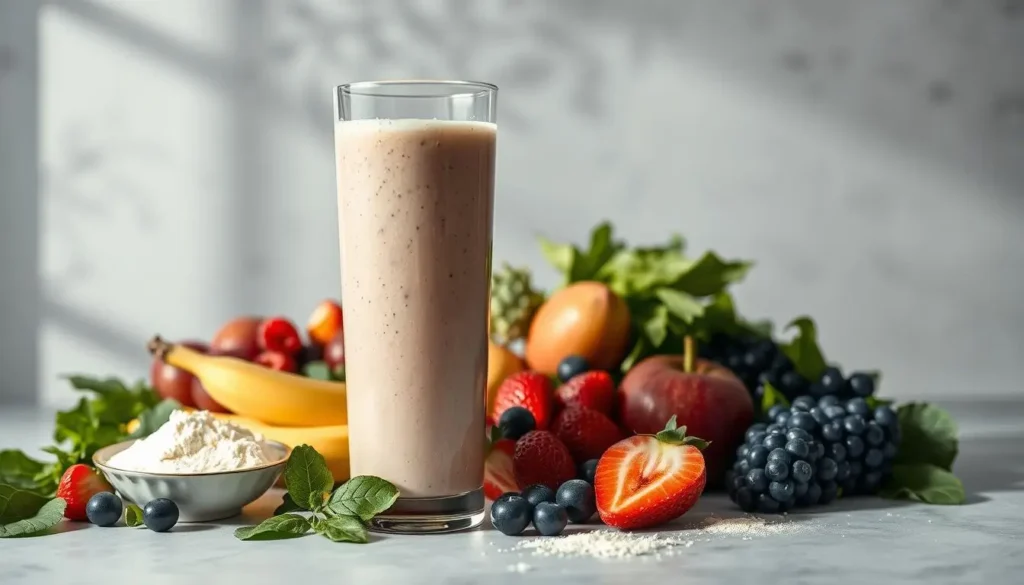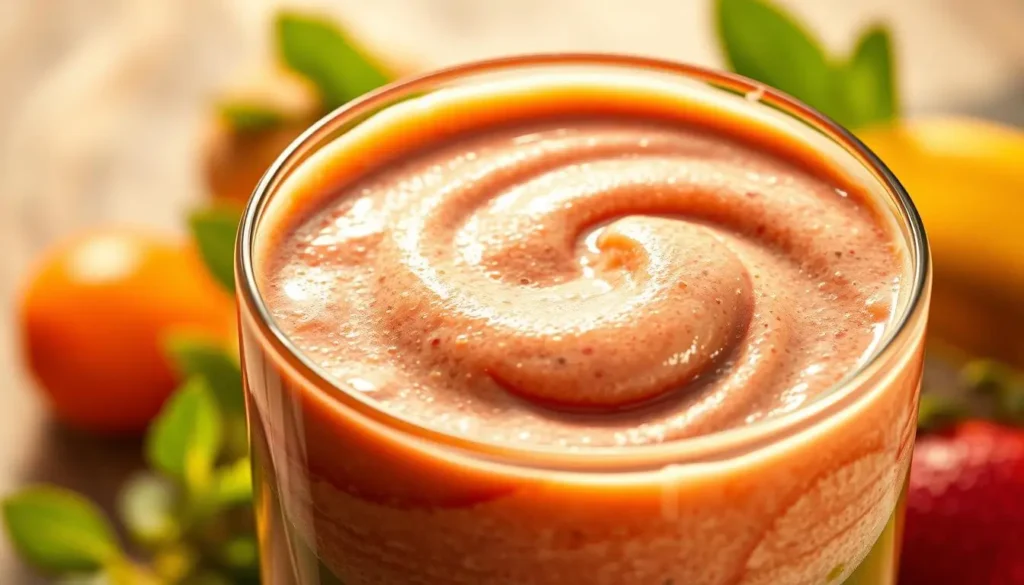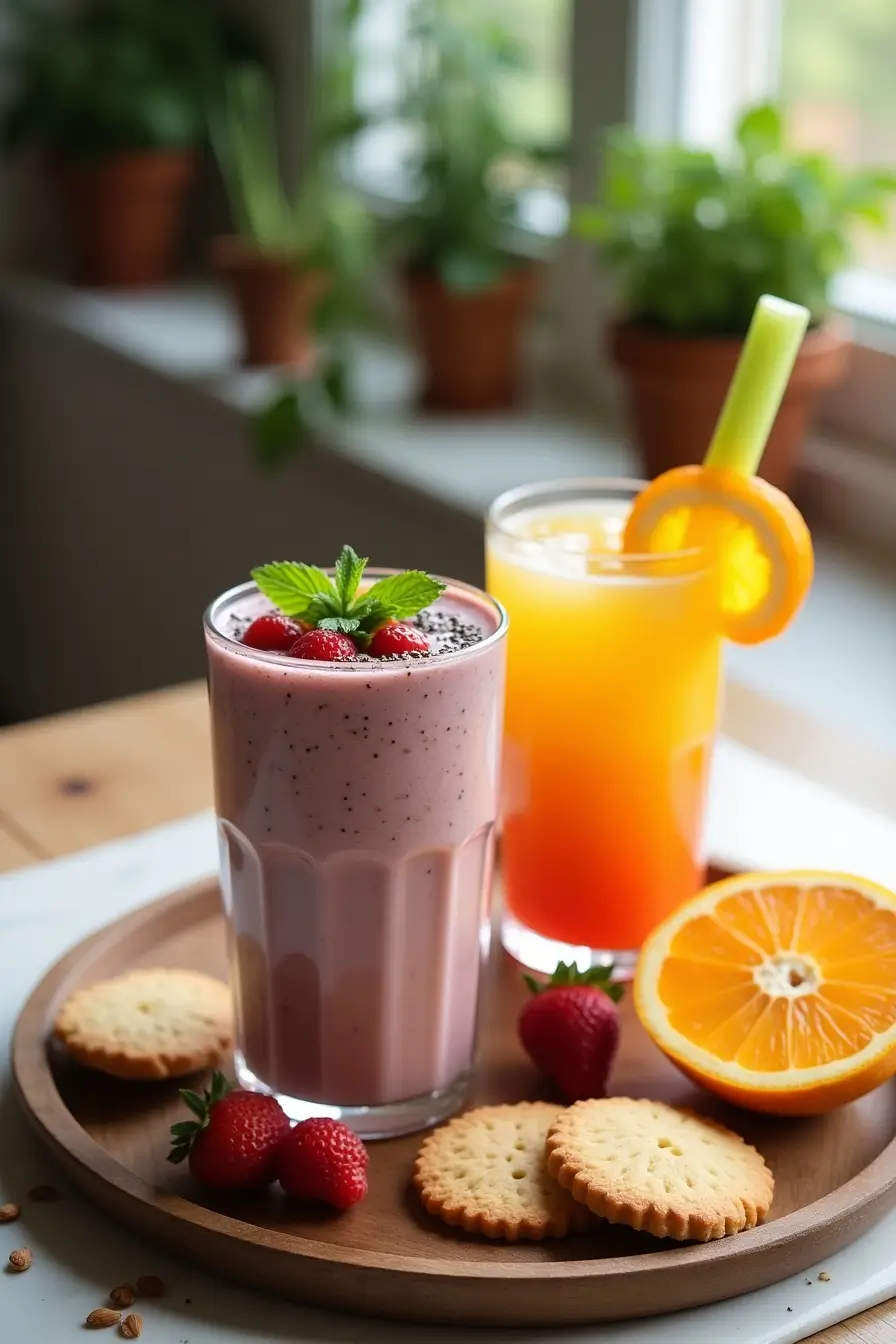Protein Smoothies vs. Juices: Which is Better for Weight Loss?
Protein Smoothies vs. Juices Choosing between nutritious beverages for weight loss isn’t easy. You might have thought about both smoothies and juices for their health benefits and ease of use.

Both have unique advantages for your weight goals. Knowing their differences is key to managing your weight well. The right drink can boost your dietary routine and help you reach your targets.
Table of Contents
Key Takeaways
- Understanding the differences between smoothies and juices is crucial for weight loss.
- Nutritional value and convenience are essential considerations when selecting a beverage.
- Smoothies tend to provide greater satiety due to their fiber content.
- Juices deliver a concentrated supply of vitamins and minerals.
- The optimal choice is contingent upon your specific weight management objectives.
Understanding the Difference Between Smoothies and Juices
It’s important to know the difference between protein smoothies and juices for weight loss. Both are healthy drinks but differ in how they’re made and what they offer nutritionally.
What Defines a Protein Smoothie
A protein smoothie mixes fruits, veggies, protein, and liquid. The blending process retains the fiber, enhancing its filling properties. You can add whey protein or plant-based protein powders to increase protein.
What Constitutes a Juice
Juices are liquid extracts from fruits or veggies, made by juicing or cold-pressing. This method removes pulp and fiber, leaving a drink rich in vitamins and sugars. Unlike smoothies, juices have little to no fiber, affecting their fillingness and nutritional value.
| Characteristics | Protein Smoothies | Juices |
|---|---|---|
| Fiber Content | High | Low/Negligible |
| Protein Content | High (due to added protein sources) | Low/Negligible |
| Preparation Method | Blending | Juicing or Cold-Pressing |
| Satiety | More filling due to fiber and protein | Less filling due to lack of fiber and protein |
The Nutritional Profile of Protein Smoothies
To achieve weight loss, it is crucial to understand the contents of your protein smoothies. You can create a beverage that is both nutritious and flavorful by combining various nutrient-rich ingredients.
Protein Content and Its Importance
Protein is vital for losing weight. High protein smoothies assist in prolonging satiety, which can facilitate the attainment of your weight loss targets. Aim to incorporate a minimum of 20 grams of protein in each smoothie.
Fiber Retention in Smoothies
Smoothies keep the fiber from fruits and veggies, unlike juices. This fiber aids digestion and contributes to a prolonged feeling of fullness. It’s important for losing weight healthily.
Caloric Density and Macronutrient Balance
An effective low-calorie protein smoothie contains a balanced array of nutrients. It gives you energy without too many calories. Consider the calorie content and nutrient composition of your smoothie to support weight loss efforts.
| Nutrient | Benefit | Example Ingredients |
|---|---|---|
| Protein | Promotes satiety and muscle preservation | Whey protein, Greek yogurt, nuts |
| Fiber | Aids digestion and promotes fullness | Fruits, vegetables, chia seeds |
| Healthy Fats | Aid in energy and nutrient absorption | Avocado, nuts, seeds |
Comprehending the nutritional value of protein smoothies enables you to create effective weight loss beverages that are both healthy and pleasurable to consume.
The Nutritional Profile of Juices
When it comes to weight loss, knowing what’s in your juice is key. Juices are often seen as healthy, but their nutritional value can change a lot. This depends on what’s in them and how they’re made.
Vitamin and Mineral Content
Juices are packed with vitamins and minerals, especially if they’re made from different fruits and veggies. For example, cold-pressed juices give you a lot of vitamins A and C, potassium, and more. These nutrients are important for your health and can help with weight loss.
Sugar Content Concerns
One big worry about juices is their sugar. Unlike whole fruits, juices don’t have fiber. This indicates that sugar enters your bloodstream rapidly, potentially elevating your blood sugar levels. This is bad for people trying to lose weight or those with diabetes.
Lack of Fiber and Protein
Juices also don’t have much fiber or protein. Fiber helps you feel full and keeps your digestive system healthy. Protein is important for muscle and feeling full. Without these, juices might not keep you full, leading to eating too much. On the other hand, protein smoothies for muscle gain and weight loss have protein, fiber, and healthy fats, making them more filling.
In summary, juices can be beneficial for weight loss due to their vitamin and mineral content. But, they lack fiber and protein and have a lot of sugar. Knowing this can help you decide if juices are right for your weight loss plan.
Protein Smoothies for Weight Loss: The Science Behind Their Effectiveness
Protein smoothies play a big role in weight loss. They help you feel full, keep your muscles strong, and boost your metabolism. Drinking a protein smoothie is more than just a quick meal. It’s a way to get the nutrients you need to lose weight.
How Protein Promotes Satiety
Protein is more filling than carbs or fats. It takes longer to digest, so you stay full longer. Research shows that eating more protein can help you lose weight and keep your body in shape.
Adding protein smoothies to your diet can help you eat less. You’ll feel fuller, making it easier to follow your weight loss plan.
Muscle Preservation During Weight Loss
During weight loss, there is a risk of losing muscle mass as well. Protein smoothies help keep your muscles strong. This is key for people who exercise to lose weight.
Keeping your muscles strong helps your metabolism stay high. This supports your weight loss journey.
Metabolic Benefits of Protein
Protein requires more energy for digestion compared to other food types, resulting in your body expending more calories simply by processing protein. It also helps control blood sugar and improve insulin sensitivity.
| Benefits | Description | Impact on Weight Loss |
|---|---|---|
| Satiety | Protein takes longer to digest, keeping you fuller for longer | Reduces hunger, making it easier to stick to a weight loss diet |
| Muscle Preservation | Provides essential amino acids for muscle maintenance | Supports metabolism and overall weight loss |
| Metabolic Benefits | Increases resting metabolic rate due to higher thermic effect | Enhances calorie burn, supporting weight loss efforts |
Juices and Weight Loss: Potential Benefits and Drawbacks
Juices have a complex role in weight loss. They are packed with nutrients but don’t always help with losing weight.
Micronutrient Density and Detoxification Claims
Juices are known for their high nutrient content. They provide a wealth of vitamins and minerals. Some people think they help detoxify the body, which could aid in weight loss.
But, our bodies already have ways to detoxify, like the liver and kidneys. While juices are good for health, their detox benefits are often overstated.
Blood Sugar Spikes and Hunger Stimulation
Juices can quickly raise blood sugar levels. This is because they have a lot of natural sugars without the fiber found in whole fruits. This can make you feel hungry and might lead to eating too much.
For those trying to lose weight, this is a big problem. On the other hand, low calorie protein smoothies can be better. They mix protein, fiber, and healthy calories in a balanced way.
To get the most from juices, blend them into best protein smoothie recipes. This way, you get a mix of protein, healthy fats, and complex carbs. It assists in maintaining stable blood sugar levels and prolongs the feeling of fullness.
Comparing Fullness Factors: Why Protein Smoothies Keep You Satisfied Longer
Understanding what sustains your satiety between meals is crucial. Protein smoothies stand out because of their mix of ingredients.
The Role of Fiber and Protein in Satiety
Protein smoothies have protein and fiber, both important for feeling full. Protein takes longer to digest than carbs, so you stay full longer. Fiber also slows digestion, adding to the full feeling.
Research shows that eating more protein and fiber can help you lose weight.

Liquid Calories and Hunger Signals
Juices might seem low in calories, but they lack fiber and protein. Liquid calories can trick you into eating more. This can stop you from losing weight.
On the other hand, protein smoothies are thick and textured. They tell your brain you’ve eaten a big meal.
Adding protein smoothies to your diet helps control hunger. It also supports your weight loss goals.
Best Protein Sources for Weight Loss Smoothies
Choosing the right protein is key for a weight loss smoothie. It helps you feel full, keeps muscles strong, and boosts your metabolism.
Whey Protein Options
Whey protein is a top pick for weight loss smoothies. It’s high quality and absorbs quickly. Weight loss benefits include enhanced satiety and muscle preservation.
Benefits for Weight Loss
Whey protein reduces hunger and helps keep lean muscle. This is important when you’re losing weight.
Recommended Brands and Types
Look for brands like Optimum Nutrition or MusclePharm for quality whey protein. Choose unflavored or lightly flavored to avoid sugars.
Plant-Based Protein Powders
Plant-based proteins are great for vegans. Vegan Options for Weight Management include pea, rice, and hemp proteins.
Vegan Options for Weight Management
Pea protein, for example, is full of amino acids and helps muscles grow.
Combining plant proteins ensures a complete amino acid profile.
Mixing plant proteins, like rice and pea, gives you all amino acids. This supports health and weight loss.
Whole Food Protein Additions
Adding whole foods to your smoothies boosts protein and fiber. It also adds healthy fats.
Greek Yogurt and Cottage Cheese
These dairy products are high in protein. They also make your smoothies creamy.
Nuts, Seeds, and Nut Butters
Almonds, chia seeds, and peanut butter are protein-rich. They also offer healthy fats.
Protein Combinations for Complete Nutrition
Mixing different proteins gives you all amino acids. This supports overall nutrition.
Balancing Macronutrients
Ensure your smoothie includes protein, healthy fats, and carbohydrates. This gives you lasting energy.
Protein Timing for Optimal Results
Drink protein smoothies after working out or as a meal. This helps with weight loss and muscle recovery.
How to Make Protein Smoothies: Step-by-Step Guide
Creating protein smoothies is easy with the right tools and knowledge. You can create smoothies that align with your dietary preferences and taste. It starts with choosing the right equipment and ingredients.
Essential Equipment for Perfect Smoothies
You need a few key items to make a great smoothie. A high-powered blender is vital for effectively blending tough ingredients such as frozen fruits and ice. Also, use a measuring cup or scale to measure your ingredients accurately.
Base Ingredients and Liquid Options
There are many base ingredients for your smoothie. You may utilize Greek yogurt, almond milk, or coconut water. Incorporating frozen fruits such as berries or mango enhances both sweetness and creaminess.
Protein Additions and Measurements
Adding protein powder is key for a protein smoothie. Choose from whey, pea, or plant-based powders. Use one to two scoops, based on your protein needs.
Flavor Enhancers Without Added Calories
To add flavor without extra calories, try spices like cinnamon or nutmeg. Natural sweeteners like stevia or honey work well too. Experiment with extracts like vanilla or almond for unique tastes.
5 Low-Calorie Protein Smoothie Recipes
Here are five tasty and healthy protein smoothie recipes:
Berry Protein Blast
Green Protein Machine
Chocolate Peanut Butter Protein Shake
Tropical Protein Paradise
Coffee Protein Energizer
These recipes provide a diverse range of flavors and ingredients. Feel free to adjust them to your liking.
Protein Smoothies for Different Goals and Needs
Protein smoothies can help you lose weight, gain muscle, or stay healthy.
The key lies in selecting the appropriate ingredients to meet your objectives and requirements.
Protein Smoothies for Breakfast
Starting your day with a protein smoothie is a great way to eat well. Mix your favorite protein powder with frozen fruits, spinach, and a liquid of your choice. It’s a quick and healthy breakfast.
Protein Smoothies for Muscle Gain
Protein smoothies are particularly beneficial for individuals aiming to increase muscle mass. Consider adding banana, peanut butter, or full-fat coconut milk to boost calorie content. Remember to include a scoop of your preferred protein powder.
Protein Smoothies for Women
Women can make protein smoothies that meet their nutritional needs. Try adding berries for antioxidants, Greek yogurt for more protein, or flaxseed for omega-3s.
Protein Smoothies for Men
Men can also make their protein smoothies work for their fitness goals. Banana serves as a source of potassium, protein powder aids in muscle recovery, and almond milk offers a low-calorie foundation.
| Goal | Key Ingredients | Benefits |
|---|---|---|
| Breakfast | Frozen fruits, spinach, protein powder | Nutritious start, energizing |
| Muscle Gain | High-calorie ingredients, protein powder | Increased protein intake, muscle support |
| Women’s Health | Berries, Greek yogurt, flaxseed | Antioxidants, extra protein, omega-3 |
| Men’s Health | Banana, protein powder, almond milk | Potassium, muscle repair, low-calorie |
Strategic Timing of Protein Smoothies for Maximum Weight Loss Benefits
Timing is everything when it comes to protein smoothies for weight loss. Drinking them at the right times can boost your results. Find out when to enjoy your protein smoothies for the best benefits.
Pre and Post-Workout Considerations
Drinking a protein smoothie before working out gives you energy and protects your muscles. Post-workout, a smoothie facilitates muscle recovery and repair. Try to have a smoothie with 20-30 grams of protein within 30-60 minutes after exercising.
Meal Replacement Strategies
Using protein smoothies as meal replacements can help you lose weight. Swap one or two meals a day with a smoothie to cut calories but keep nutrients. Make sure your smoothie has protein, healthy fats, and complex carbs for a balanced meal.
Nighttime Protein Smoothies for Recovery
Drinking a protein smoothie before bed helps your muscles recover while you sleep. Casein protein is great because it digests slowly, releasing amino acids over time. This process supports muscle restoration and prepares you for the following day.
| Timing | Purpose | Protein Recommendation |
|---|---|---|
| Pre-Workout | Energy and Muscle Protection | 15-20 grams |
| Post-Workout | Recovery and Muscle Repair | 20-30 grams |
| Meal Replacement | Weight Loss and Nutrition | 20-30 grams |
| Nighttime | Muscle Recovery | 20-30 grams (Casein) |
Conclusion: Making the Right Choice for Your Weight Loss Journey
Your choice between protein smoothies and juices depends on what you like and your weight loss goals. If you want something filling and healthy, protein smoothies for weight loss might be the best. They have protein, fiber, and calories to keep you full.
Try adding best protein smoothie recipes to your meals. These recipes can be made to fit your needs, like a post-workout snack or a meal substitute.
Knowing the good and bad of both protein smoothies and juices helps you choose wisely. Try out different ingredients and recipes to see what’s best for you.
FAQ
What is the main difference between a protein smoothie and a juice?
A protein smoothie has protein, fruits, veggies, and sometimes dairy. It’s thick and creamy. A juice, on the other hand, is just the liquid from fruits and veggies, without pulp or fiber.
Are protein smoothies or juices better for weight loss?
Protein smoothies are better for weight loss. They have more protein and fiber, which helps you feel full and keeps muscles strong. Juices are high in sugar but lack fiber and protein, making them less effective for losing weight.
How much protein should I include in my weight loss smoothie?
The right amount of protein in your smoothie depends on your age, sex, weight, and how active you are. Aim for 20-30 grams of protein per serving.
Can I use whey protein or plant-based protein powders in my smoothies?
Yes, you can use whey or plant-based protein powders in your smoothies. Whey is a complete protein with all essential amino acids. Plant-based proteins are good for those who can’t have dairy.
Are there any specific protein smoothie recipes that can help with muscle gain?
Yes, you can make smoothies for muscle gain. Add banana, peanut butter, or almond butter for extra calories and nutrients.
Can I have a protein smoothie for breakfast, and is it a good meal replacement?
Yes, a protein smoothie is a great breakfast choice. Make it a meal replacement by adding protein, healthy fats, and complex carbs like fruits, veggies, and whole grains.
How often should I consume protein smoothies for weight loss?
The right frequency of protein smoothies for weight loss varies. You can have one or two smoothies a day, depending on your diet and activity level.
Are there any benefits to having a protein smoothie before or after a workout?
Yes, protein smoothies are good before or after workouts. A pre-workout smoothie gives energy and supports muscles. A post-workout smoothie helps with recovery and replenishes energy.
Can I customize protein smoothies for my specific dietary needs and preferences?
Yes, you can customize protein smoothies to fit your dietary needs. Try different ingredients and protein sources to make a smoothie that suits you.

